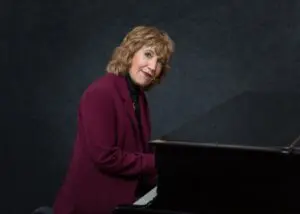Though Debra Kaye bills herself as a contemporary composer, it’s surprising to listen to one of her new works and hear 13 minutes of jazz played by a quartet featuring a saxophone.
If classical music can swing, this is the thing.
“I like having at least a couple of items on the plate,” says Kaye, who lives in Beacon and describes herself as a “hybrid” composer. “I’m a classical piano major who studied jazz, so I’m open to different influences and appreciate improvisation.”

Her most recent album, Time Is the Sea We Swim In, released in March on Navona Records, is a compendium of compositions (including that jazz track), most recorded in 2022.
If saxophones and drum kits are rare in classical music, the shakuhachi is almost non-existent. Kaye’s piece, “Three Zen Poems,” combines the Japanese wind instrument with cello and viola.
The new collection follows another release from 2023, Ikarus Among the Stars, which includes the title work and 10 others. “I experienced some creative moments during COVID and this is the result,” she says.
Kaye splits her time between Manhattan, where she attended and taught at Mannes College of Music, and Beacon, where she bought a house 10 years ago before the city “popped.”
Some of her contributions to the fertile local classical music scene include hosting an annual Composers Collaborative at the Howland Cultural Center (coming June 23) and premiering the composition “Time is the Sea We Swim In” for violin, cello and piano during a Howland Chamber Music Circle performance in 2020.
Many of Kaye’s pieces are programmatic and attempt to convey their titles’ themes. One is called “Ukraine 2022,” another, “Dialogue with a Ghost.”
In 2018, she commemorated the 25th anniversary of the Chamber Music Circle with “String Quartet No. 2 – The Howland.” A recording of the premiere, performed by the Voxare Quartet, is included on the new album.

According to the liner notes, the challenging modern work reflects “the founding, growth and the ongoing spirit that sustains it and which remains an enduring legacy.”
It begins with bows skittering across the strings, then segues into clashes of intensity and silence. In the second movement, titled “The beauty of the dream upon reflection,” she quotes Tchaikovsky’s first string quartet, completed in 1873, a year after the Howland building’s completion.
“The first violin takes up the melody and yields to a duet with the cello, symbolizing the founders’ shared vision,” she writes.
A video, shot from the balcony during the recording, shows the players lean into the work as they balance melody and dissonance.
On viola, Erik Peterson swayed in his seat, cellist Wendy Law bopped along with a plucked melodic part in the third movement and the performers smiled after nailing the hot-potato handoff between instruments leading to the final violin note.
Kaye’s movement for jazz quartet, “Colossus 1067,” commissioned by a New Mexico artist, Gus Foster, is named for a massive wooden roller coaster and the three rotational degrees of a panoramic camera he used to film one of the last rides before its dismantling in 2014.
In her notes, Kaye writes about blending “pattern and serendipity. Each instrument has its role, but changes it up from time to time. Piano, bass and drums portray the clatter of the coaster and the machinery of its gears.”
Though tenor sax takes center stage, the piano dissolves into classical-esque glissandos as the rhythm section lopes along with a thrill ride’s twists and turns. The herky-jerky score reflects physical chaos as individual instruments fade in and out.
“I’m not the most envelope-pushing hybrid composer out there,” says Kaye. “But I seek an individual expression that is authentic, meaningful and visceral. I want to have flow, in whatever way that means.”
Debra Kaye’s albums can be streamed or purchased from major services or through debrakayecomposer.com.

